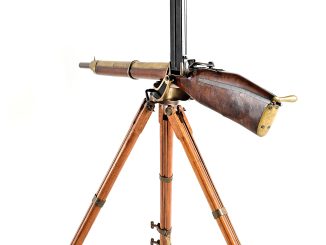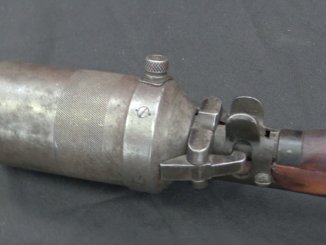Following up yesterday’s look at the history and mechanics of the Webley-Fosbery self-cocking revolvers, today we are out at the range to do some shooting with one.
In terms of handling, it is a comfortable gun to shoot, albeit with some exaggerated recoil because of the very high bore axis relative to the hand. It has an interesting two-part recoil sensation, because the upper assembly takes quite a long time to return forward into battery.
Most importantly, we discovered that this particular Webley-Fosbery has a worn hammer engagement, which results in the firing pin coming into contact with cartridge primers even when it is in the safety notch. In other words, it can – and will – sometimes fire when the action is closed and without any manipulation of the trigger. This is a condition that could happen to any Fosbery revolver, so owners should handle them with this possibility in mind! This is also a great example of why gun safety rules are redundant – occasionally guns do have mechanical failures, so don’t point them at anything you don’t want to shoot!
Thanks to Mike Carrick of Arms Heritage magazine for providing this Webley-Fosbery for this video! Make sure to check out his column!




Never had that loading safety issue with mine, then again my ownership and shooting was pre-fiocchi, I wonder if the fiocchi primers are a bit sensitive. Older guns often require extra care of course. Absolutely loved mine.
When I rapid-fired mine, I noticed a bit of rolling sensation also. I was able to empty the cylinder (six shots) in about 1.5 seconds if memory serves.
I had a shooting buddy who was a collector of things Brit. He owned a Webly-Fosbery which I had the opportunity to shoot. It was a fun and interesting revolver to shoot. It too had an issue with worn century old parts. It would on occasion double. One must treat these delightful old firearms with great care and consideration.
Pretty spiffing that isn’t it.
Profoundly spiffing.
On my Webley Mk.VI the hammer doesn’t descend all the way unless the trigger is depressed, thereby keeping the firing pin well clear of the primer. I wonder if this was only a feature of later Webleys, or whether that feature was lost in the modification of the Webley-Fosbery?
My MkI also has the firing pin block that only drops when the trigger is pulled
“It has an interesting two-part recoil sensation, because the upper assembly takes quite a long time to return forward into battery.”
I am wondering how would .455 version compare to .38?
Later seems to be rarer (does anyone know how many .455 and how many .38 were made)?
I am also wondering about choice of cartridge – .38 Auto for one version, which was automatic pistol round. Possibly it was chosen under impression of Browning trend – Browning’s automatic pistol become so popular in early 20th century, that revolvers manufactured created Browning-style, like for example:
http://historypistols.ru/blog/revolvery-pod-unitarnyj-patron/belgijskij-revolver-velodog-fason-brauning-kalibra-635-mm/
chambered for Browning’s automatic pistol’s cartridge, though mainly 6,35 mm (.25 Auto) and 7,65 mm (.32 Auto)
I found data for .38 version here:
https://jamesdjulia.com/item/1332-369/
(…)Webley’s surviving production and sales records show that only 107 of these revolvers in this caliber were sold, the remainder of the total of 417 originally produced in the period 1902-1903 being converted to .455” caliber or scrapped for parts before 1914(…)
Though this description seems to be somewhat inconsistent, as it gives .38 S&W as caliber but 38 AUTOMATIC as marking.
The caliber was definitely .38 ACP and not .38 S&W. The gun was loaded using full moon clips. My guess is that .38 ACP was chosen because it was more powerful than the existing rimmed .38 revolver cartridges.
STANDARD BALLISTIC OF KYNOCH CENTRAL-FIRE METALLIC CARTRIDGES gives
130 gr. Metal-covered bullet over 6 grs. smokeless powder for 1050 fps
That would be a typical post-WW1 loading. The original .38 ACP loadings were a good deal “hotter”, with muzzle velocity up to 1,260 fps with a 125 or 130 grain bullet. The later factory loads were reduced because the Colt M1900 was not durable enough for a steady diet of the original loads. However, the Webley-Fosbery in .38 ACP was designed in 1903, so it appears likely that the cylinder was designed to withstand the early, more powerful loadings.
STANDARD BALLISTIC OF KYNOCH CENTRAL-FIRE METALLIC CARTRIDGES is available here:
http://www.hoferwaffen.com/images/ballistics/kynoch.pdf
sadly, this scan lack any information about when original was printed, though considering from listed cartridge, it must be created not earlier than 1912 – it listed .375 Magnum under name ·375 Belted Rimless Magnum Nitro-Express which was introduced in 1912.
Interestingly it also list some cartridge described as walking stick which suggest usage in walking-stick-gun weapon.
“1,260 fps with a 125 or 130 grain bullet”
This might explain choice of that cartridge, as it was quite close to .455 Webley momentum-wise, it should allow to make such revolver work with smaller alteration, than more different cartridge
Original .38 will give 157 500 to 163 800
.455 Webley (as listed in Kynoch) will give either 159 000 (smokeless) or 188150 (black-powder)
I am wondering if Fosbery ever discussed with Whiting (designer of Webley’s automatic pistols), about their handguns.
I think that automatic revolver might attain greater success in smaller version, as sportsman’s revolver say in .32 S&W Long (or any similar British cartridge from that era) – if used for target shooting bigger dirt sensitivity that in case of “normal” revolver would be of less concern.
“Spiffing”? Is there an English to Yank translation?
“English to Yank translation”
I know only about Yank to English, yet from 1942, titled How the British Say It:
http://www.lonesentry.com/articles/intelligence-report/how-british-say-it.html
Splendid! Is a synonym for splitting! As are: marvellous; stonking; cracking; and ‘the top dog’s bollocks’.
Translation is: Cool
In spite of any faults, major or minor, the Webly-Fosbery is one cool and interesting firearm. Thank you for this, especially the slo-mo shot showing the cylinder cycling.
Let’s get down to business, part two: since Ian for some unfathomable reason did not reference it in any way in his shooting video, it is my duty and pleasure to post the pivotal opening scene from the eternal classic that is Zardoz (possibly not safe for work):
https://youtu.be/EwZhKGgmoUI
😀 😉
Oh God no. Not Zardoz……..
Why not try the Mateba revolvers?
Mateba revolver is interesting design as it fire from bottom chamber, rather than top, thus being “upside-down” from point of view of classic revolver crafting.
That feature might be also found in few other revolver, which are classic in sense that they are not automatic, as AEK-906 revolver:
http://gunrf.ru/rg_revolver_Nosorog_eng.html
That layout allow better recoil control, similar in principle automatic pistol (“upside-down”), named МЦ-3 «Рекорд»:
https://ru.wikipedia.org/wiki/МЦ-3_«Рекорд»
it was used by Soviet Union teams, most notably in 1956 Olympics (Melbourne), after which such designs were banned
I am wondering about possibility of crossing zig-zag cylinder with barrel swap feature (cf. Dan Wesson revolver). This should allow wide choice of calibers(without fixing capacity) with just barrel and cylinders swap.
I know about Cobray Pocket Pal, but this weapon was limited to 2 caliber options only.
Your site has a lot of useful information for myself. I visit regularly. Hope to have more quality items.
Proper way to eject empties from any Webley top break is to hold the barrel horizontal and swing the grip down. Grabbing the barrel and swinging it from horizontal to vertical can cause the extractor star to slip over the empty cases and allow the cases to drop back into the cylinder. The extractor will then close on the empties and you have a right mess getting the empties out. If you keep the barrel horizontal and drop the grip down the empties spill out nicely and fall free. Thanks for all the great videos.
Older guns often require extra care of course. Absolutely loved mine.